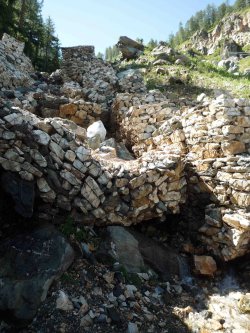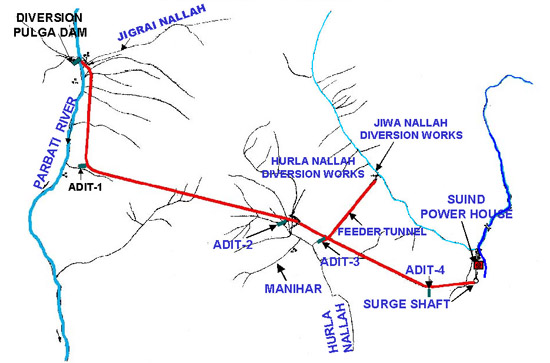Article and Image courtesy: International Rivers
Author: Samir Mehta
Samir Mehta from International Rivers journeys Himachal Pradesh and writes about the severe impacts of small hydro projects on communities and ecosystems.
 Wall meant to protect the stream from debris of Parbati II project collapsed into the stream at Raila Village
Wall meant to protect the stream from debris of Parbati II project collapsed into the stream at Raila Village
It is with mixed feelings of joy, hope and despair that I return after a survey of some of the proposed, under construction and completed hydroelectric projects in the north Indian State of Himachal Pradesh. Joy, which people continue to fight for their rights and against corporate efforts to own rivers, hope that their struggles will bear fruit, and despair at the injustices done to them. During my 10-day trip, I surveyed a dozen or so hydropower projects of all sizes in the Satluj and Ravi river basins. The projects are wreaking havoc on livelihoods and the environment.
Himachal Pradesh includes three main mountain ranges; the Dhauladhar, Pir Panjal and Great Himalayan ranges. The climate and beauty of the region prompted the British to make Shimla their summer capital. The rural landscape is dotted with small villages and fields. The state is also famous for its apples. The soil is fertile and the people are not poor. The steep topography is conducive to construction of dams. The state has identified hydropower as one of its main sources of revenue and pegged its hydropower generation potential at 23,000 MW. The present generation is about 7,000 MW.
What is most disturbing is that even locally important brooks and streams have not been spared from maximum exploitation for hydropower generation and even have cascading power plants on them. The snow- and glacier-fed Tarela brook is one such example. Most of the brook has been diverted into channels to support four hydropower projects of 5 MW each. This has resulted in the shutdown of more than 50 water mills and water-powered wool carding machines (the locals predominantly rear sheep/goat). The water mill owners were promised benefits, but no agreements were signed and the monthly payments were discontinued after the projects came into operation. Nearly half of the water-mill owners who had been operating for decades were not compensated. Another common impact on local communities is the indiscriminate dumping of debris, which harms forests and watercourses. Hydropower projects less than 25 MW are not required to carry out Social Impact Assessment and Environmental Impact Assessment, despite the fact that they can have serious impacts.
 The Endangered Western Tragopan
The Endangered Western Tragopan
Rivers and streams are being diverted from one valley into another, with serious impacts. The 800 MW Parbati-II Hydroelectric Project is one such example. The Parbati River is just one of a number of rivers and streams being diverted through a long tunnel from the Parbati valley into the Sainj valley. A part of the Great Himalayan National Park was de-listed to permit the project to go forward, despite the fact that the area was a prime nesting site for the rare Western Tragopan bird, for the conservation of which the park has been set up. Another project will devastate a local apple-growing community by drying up about 35 of their water springs.
 Layout of Parbati II Project
Layout of Parbati II Project
Projects are being built and proposed at higher and higher altitudes and closer and closer to the snowline (and the Chinese border). The Kashang projects start around 3,000 m. (10,000 feet). If one is to go by the ecological devastation caused by projects at lower altitudes, the prospect of what will happen to the fragile Alpine ecosystem is frightening. Himanshu Thakkar, Coordinator of SANDRP, says that the projects will change the microclimate which will result in accelerated melting of the snow and glaciers. The strategic implications of having these projects so close to the border with China are not being discussed in the public domain.
Cascade dams do not leave any stretch of the river flowing free. Sutlej River originates from Lake Rakshastal in China. It enters India in Kinnaur District of the State. Within 7 kms (4.3 miles) of entering India it flows from one tunnel into another. All these projects are so-called run-of-river projects. It is funny (in a sad way) how these projects are proposed. It is said that the powerhouse of the proposed 261 MW Yangthang-Khab project will be submerged in the reservoir of the proposed 1020 MW Khab-Shaso project. Both project proponents are in a race to acquire all permissions and sanctions before the other to win the battle of the duelling dams.
 Forests destroyed by illegal debris dumping for Tidong I project
Forests destroyed by illegal debris dumping for Tidong I project
Such situations are arising even when a committee set up by the state’s High Court has recommended that, pending further studies, rivers should flow free for at least 5 kms (3 miles) between dams. The Ministry of Environment and Forests is not taking a clear stand on what should be the minimum distance that the river must flow freely. Hence State Governments and other agencies are permitting such cascading dams which essentially bottle up long stretches of rivers. The Ministry is aware of the implications of such a large number of dams in a river basin and has hence sought cumulative impact assessments of many river basins. However, at the same time it continues to sanction hydropower projects without waiting for the report. In the case of the Sutlej river basin, the agency that has been selected to do the cumulative impact assessment is the Forum of Independent Hydropower Producers. Apparently no one in Government will admit that this is a clear case of conflict of interest.
The Government and Courts have put a price on natural resources. The philosophy is that economic considerations override environmental considerations. Hence one can pay the monetary price and destroy the environment. This is being increasingly challenged and questioned by civil society. With regard to hydropower, civil society is mobilizing against India’s destructive energy policy.
During my travels I had discussions with many local NGOs and civil society on strategies for protecting their rivers and rights. In coming months, I'll be helping them with information, analysis and advocacy. The magnitude of the tasks ahead is daunting, as borne out by a statement from a resident of the region: "Mahatma Gandhi himself may have found fighting these dams more challenging – he had only one enemy, the British. We have the dam developers, contractors, construction industry, and misguided politicians and bureaucrats". It's a big challenge, but we'll use all our strength to ensure that economic development does not supersede all else, that natural resources are not treated as commodities with artificial economic values attached to them, that environmental flows are maintained, and livelihoods and social impacts are addressed.
/articles/small-not-always-beautiful-journeys-through-himachal-pradesh-show-us-severe-impacts-small